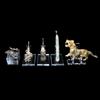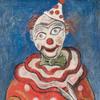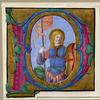An Embodied Dialogue Between the Earthly and the Spiritual, The Work of Alison Saar Is Shown Together In Major Survey
- June 21, 2021 13:02
“A lot of my life has been a balancing act between anger and a kind of serenity, and that’s also reflected in my process.” - Alison Saar
California's Benton Museum of Art at Pomona College and the Armory Center for the Arts in Pasadena will present the largest museum survey to date of the work of American artist Alison Saar. Alison Saar: Of Aether and Earthe (through December 19, 2021 at the Benton; July 16–December 12, 2021 at the Armory) includes 29 of the artist’s multi-media and mixed installation works installed across the two venues. This exhibition spans the broad spectrum of Saar’s career, from her sculptures of the early 1980s to the large-scale, site-specific commission Imbue, installed at the Benton Museum of Art in the summer of 2020, and a new installation, Hygiea, to be unveiled at the Armory in 2021. Both venues require an appointment to visit the exhibition; reservations can be made at their respective websites, pomona.edu/museum and armoryarts.org. The monumental outdoor bronze sculpture at the Benton, Imbue, is accessible without an appointment, and the accompanying exhibition catalogue is also available.
Alison Saar will be in conversation via Zoom with exhibition curators Rebecca McGrew and Irene Georgia Tsatsos on Thursday, July 15 from 6 to 7 pm PST. Please contact Caroline Eastburn at caroline.eastburn@pomona.edu for the link.
Alison Saar: Of Aether and Earthe showcases fundamental principles of Saar’s artistic practice: a consistent and continually evolving experimentation with material, and an embodied dialogue between the earthly and the spiritual. Working with and through found objects, bronze, clay, seed and flour sacks, wood, wire, and other materials, Saar exposes the ground between binaries as traditional as body and spirit, sacred and secular, and material and immaterial. The title of the exhibition—“Of Aether and Earthe”—signals these intersections and is reflected in the organization and installation of the exhibition in the two venues. “Aether” is the invisible energy that, in some historical and contemporary worldviews, ties together the four conventional elements of earth, water, air, and fire. The Benton presentation, consisting of 13 works, focuses on those rooted in earth and water, and the Armory’s presentation, of 14 works, features those suggestive of fire, air, and “aether.”
Saar’s two- and three-dimensional works explore materiality as they address very contemporary issues of race, gender, and social and political oppression. Her evocation of a deep and violent past is leavened by her invocation of African and Afro-Caribbean deities and objects that offer hope, redemption, and strength. At the Benton Museum of Art, the works on view include the early Voluptuous Mummy of 1982, made in part with the linen scraps from her father’s art conservation studio. Saar repurposed these fabric strips—trimmed from paintings her father was relining and reframing—to wrap a full-length yet compact female figure, the linen obscuring the feminine curves beneath. Rendering the work with humble materials of twine, nails, and found tin and leather, Saar covers the face with an Egyptian-style mask that swings open to reveal a mosaic. A later work, Bitter Crop (2008), is a reclining female form with cotton bolls sprouting from the figure’s head, a reference to the character of Topsy in Harriet Beecher Stowe’s Uncle Tom’s Cabin (1852), described with “wooly hair braided in sundry little tails, which stuck out in every direction.” In contrast to the smooth, white marble of traditional art historical nudes, Bitter Crop is an earthly figure in red-brown, a network of webs and marks across the surface of the body. Saar transforms the Civil War–era slave into a contemporary heroine, crowned with the cotton bolls that are the symbols of her oppression. Like many of the other works by Saar at the Benton, both of these sculptures are rooted in the earth and the body.
Among the works presented at the Armory is Sapphire (1985), a blonde-haired, blue-eyed, dark-skinned female bust with her hands clasped behind her head, breasts thrust forward. Each breast swings open on a hinge to expose a fiery red candle that illuminates shards of glass in a votive-like interior. The hidden cavity in Sapphire’s breasts alludes to Central African Bakongo nkisi objects, which harness ethereal energy into charms to mystically attack slaveholders and other enemies. Saar’s Mammy Machine (2012) is a self-sufficient system in which disembodied breasts never stop lactating, representing the transformation of solids into liquids while also distilling the cultural stereotypes, economic pressures, and interpersonal expectations regarding the role of Black women, and women of color, to nurture constantly.
Saar’s figures are female; some are trussed, strung up, bent, and bowed, while others are literally elevated by female attributes such as life-giving lactation. This interplay between rage and hope is underscored in every work by a constancy of process. Saar’s is a very physical art in which her hand—holding a chisel, a brush, a hammer—is always visible, the mark of the maker always clear as she clothes myths and archetypes in the detritus of everyday life, manifesting powerful figures from wood, nails, bottles, and other humble and “found” material. As she explained in an interview in The New York Times in November 2020, “A lot of my life has been a balancing act between anger and a kind of serenity, and that’s also reflected in my process.”
Alison Saar has long been a part of the creative life of Los Angeles. Born in 1956 to mother Betye (a printmaker and assemblage artist) and father Richard (a ceramicist and art conservator), she was raised primarily in Laurel Canyon. She attributes her interest in found materials to her youth there, writing in the catalogue timeline that “at age six, we move to Laurel Canyon, and I begin to forage for roots, stones, and found objects among the ruins of the devastating Laurel Canyon fire of 1959. Having free rein in this semi-rural setting hones my love for flora and fauna.” She graduated from Scripps College in 1978 and received her MFA from the Otis Art Institute of the Parsons School of Design in 1981. Her work has been exhibited from Brooklyn to Senegal, including in the Whitney Biennial of 1993; a solo exhibition at the Hirshhorn Museum and Sculpture Garden in Washington, DC, that same year; and the High Museum of Art in Atlanta, Georgia. Saar has completed more than a dozen public commissions, including a memorial to Harriet Tubman in Harlem, New York, and Embodied, an evocation of justice outside the Los Angeles County Hall of Justice. Saar is the recipient of fellowships from the John Simon Guggenheim Memorial Foundation and the National Endowment for the Arts, among other awards. Saar is represented by L.A. Louver in Venice, California.
The exhibition is co-curated by Rebecca McGrew at the Benton Museum of Art at Pomona College and Irene Tsatsos at the Armory Center for the Arts. It is accompanied by a catalogue, Alison Saar: Of Aether and Earthe, co-edited by McGrew and Tsatsos and featuring contributions by Camille Dungy, McGrew, Harryette Mullen, Christina Sharpe, Evie Shockley, and Tsatsos. This project is part of the Feminist Art Coalition.
Alison Saar: Of Aether and Earthe is sponsored by the Fellows of Contemporary Art. The Fellows of Contemporary Art (FOCA) awarded the 2020 Curator’s Award to Rebecca McGrew and Irene Tsatsos as co-curators of this exhibition. This award underwrites the cost of the exhibitions and scholarly catalogues of California artists developed by California curators for major museums and other art venues.















31100x100_c.jpg)




